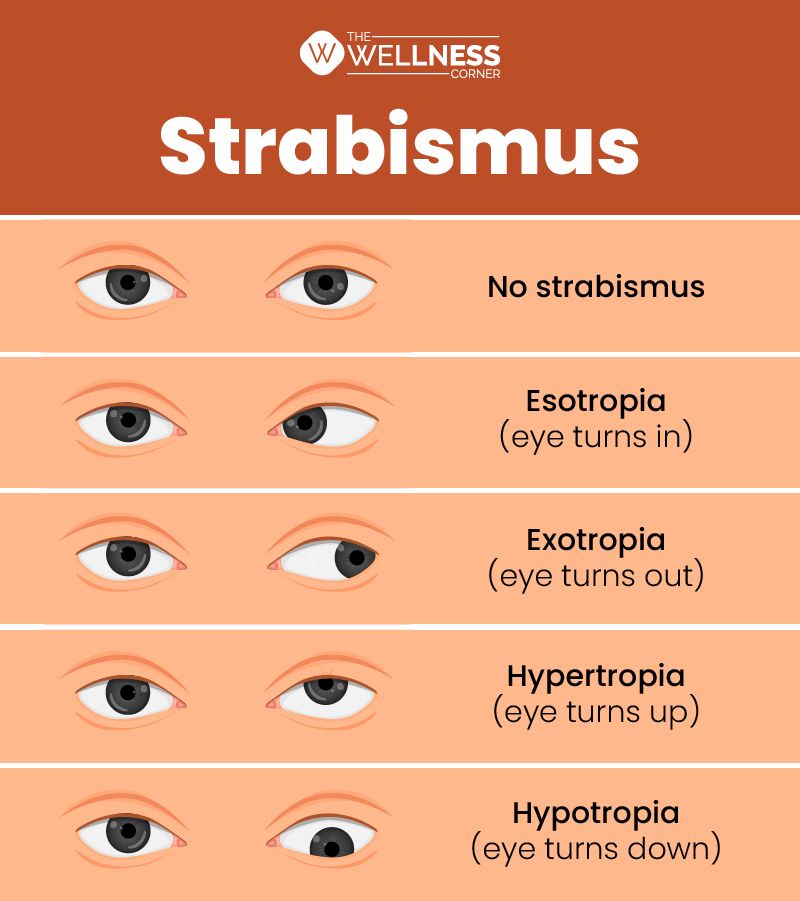Eyes That Look In Different Directions From Each Other: Strabismus
33 months ago
4 minute read.

Strabismus is a condition in which the eyes do not align with each other. In other words, each eye is seeing in a separate direction. Under ordinary situations, the six muscles that regulate eye movement cooperate and direct both eyes in the same direction. Strabismus patients have difficulty controlling their eye movements and cannot maintain proper ocular alignment.
Types of strabismus
Strabismus is categorized according to the direction of the twisted or misaligned eye:
- Esotropia
- Exotropia
- Hypertropia
- Hypotropia

1. Esotropia: In this type of strabismus, one eye turns inward towards the nose while the other remains in its normal position. The most prevalent type of strabismus in children is esotropia.
2. Exotropia: In exotropia, one eye turns outward away from the nose, while the other eye remains in its normal position. Exotropia is more common in adults than in children.
3. Hypertropia: occurs when one eye turns upward while the other remains in its normal position.
4. Hypotropia: In hypotropia, one eye turns downward while the other remains in its normal position.
Other types of strabismus
- Duane syndrome
- Congenital cranial dysinnervation disorders
- Paralytic strabismus
- Duane syndrome: Duane syndrome is a rare strabismus usually present from birth. It is characterized by the limited movement of one or both eyes, especially in an inward direction.
- Congenital cranial dysinnervation disorders (CCDDs): CCDDs are a group of rare genetic disabilities that affect the nerves that control eye movements. These conditions can cause various types of strabismus and other eye-related problems.
- Paralytic strabismus: Paralytic strabismus occurs when there is a weakness or paralysis of one or more of the muscles that control eye movements. It can be caused by various circumstances, like an injury, a sickness, or a neurological issue.
[Also check: Signs of vision problems in children]
When do strabismus symptoms appear?
The symptoms of strabismus can appear at any age, from infancy to adulthood. In some cases, strabismus may be present at birth or develop within the first few months of life. However, in other cases, it may develop later in childhood, adolescence, or adulthood.
Some common signs and symptoms of strabismus may include
- Eyes that appear to be pointed in different directions
- Double vision
- Blurred vision
- Tilting or turning to one side of the head
- Eye strain or fatigue
- Difficulty with depth perception or judging distances
- Poor eye-hand coordination
Causes of strabismus
It can be caused by a variety of factors, some of which are:
1. Muscle imbalance: The six muscles that control eye movement may not be functioning together, causing one eye to turn in a different direction.
2. Genetics: Strabismus often runs in families, suggesting that there may be a genetic component to the condition.
3. Refractive errors: If one eye is significantly more nearsighted, farsighted, or has a different level of astigmatism, it can cause strabismus.
4. Neurological disorders: Certain neurological conditions such as cerebral palsy, brain tumors, or strokes can cause strabismus.
5. Amblyopia: Also known as lazy eye, amblyopia occurs when one eye has weaker vision than the other. The brain may ignore the weaker eye, causing it to drift out of alignment with the stronger eye.
6. Eye injuries or trauma: Injuries to the eye muscles or nerves that control eye movement can cause strabismus.
[Also check: Tips for eye health and maintaining good eyesight]
How is strabismus diagnosed?
Anybody baby over four months who appears to have strabismus should have an eye examination by a pediatric ophthalmologist, with special time spent studying how the eyes focus and move.
The examination may cover the following items:
- Patient history: to discover the patient's symptoms, family history, general health concerns, medications used, and any other potential causes of symptoms.
- Visual acuity: assessing young children's visual activity or reading letters from an eye chart.
- Refraction: measuring how well the eyes concentrate light by testing them with various corrective lenses. Checking for glasses can be done on children who are not yet old enough to provide vocal feedback.
- Alignment and focus tests
- An examination is performed after pupil dilation (widening) to evaluate the state of interior ocular structures.
Treatment of strabismus
The treatment for strabismus depends on the severity of the condition and age of the patient. Here are some common approaches:
- Eyeglasses or contact lenses: In some cases, eyeglasses or contact lenses can help correct the alignment of the eyes.
- Eye exercises: Some people with strabismus can benefit from exercises that strengthen the eye muscles and improve coordination between the eyes.
- Patching: Patching one eye can sometimes help strengthen the weaker eye and improve alignment.
- Botox injections: used to weaken the muscles responsible for the eyes' misalignment.
- Surgery: In more severe cases of strabismus, surgery may be necessary to realign the eyes. The surgery involves adjusting the muscles that control eye movement.
[You may also like: Exercises to help you relax your eyes]
What might happen if strabismus is left untreated?
- Eye strain
- Fatigue
- Headaches
- Double vision
- Poor 3-dimensional (3-D) vision
- Blurry vision
- Lazy eye (amblyopia)
Conclusion
Strabismus is a condition where a person's eyes are misaligned and look in different directions from each other. It can cause a range of symptoms, including double vision, poor depth perception, and difficulties with eye contact. Strabismus can result from several factors, including genetics, nerve injury, and eye muscle abnormalities.
Strabismus can be treated using various methods, including eyeglasses, eye exercises, and surgery. Early detection and treatment are critical for avoiding long-term consequences like vision loss and enhancing the overall quality of life of individuals affected.
[Also check: Best foods to boost eye health and eyesight]
Leave a Comment
Related Articles
Health Checks @ Home
Service
Explore
© 2026 Truworth Health Technologies Pvt. Ltd.





